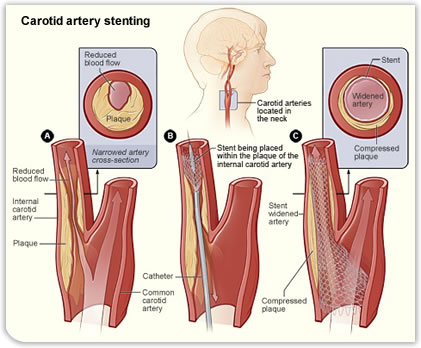What about treating with carotid artery angioplasty
and stenting rather than surgery?
Angioplasty and stenting i.e. putting a balloon into a narrowed artery and inflating it to widen the channel down the middle is widely used in the treatment of leg artery and coronary artery disease. It has also been used extensively in the management of patients with symptomatic carotid artery disease. As mentioned above, the reason that diseased carotid arteries cause stroke is usually because the plaque (furred up area) in the carotid artery has become unstable and is sending bits of debris up into the brain. This is somewhat different from the situation where someone has pain in the leg when they walk or angina, which is caused by restriction in the amounts of blood that can get through the artery. The problem with carotid artery stenting is that it involves passing guide wires and balloons up the inside of the unstable carotid artery and this unfortunately can cause bits of debris to break off. These bits of debris may then go on to cause a stroke. There have been a number of randomised controlled studies where surgery has been compared with carotid artery stenting, which have shown pretty consistently that the stroke rate with carotid artery stenting is substantially higher than the stroke rate with carotid artery surgery. So the advice in general would be that for patients with symptomatic carotid disease they are better treated with surgery rather than stenting. This is not to say that no one should ever have carotid artery stenting. There are some patients in whom surgery might be particularly difficult or hazardous, for example, people who have had previous surgery in the neck or whose disease is difficult to get at with conventional surgery and there are certainly some centres with better results than others for carotid artery stenting.
However, as general advice I would recommend that someone with symptomatic carotid artery stenosis has an operation to treat their carotid rather than carotid artery stenting although there may be individual exceptions to this. Of course the technologies are changing all the time and this may change in the future.

 Contact Me
Contact Me